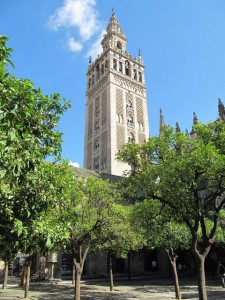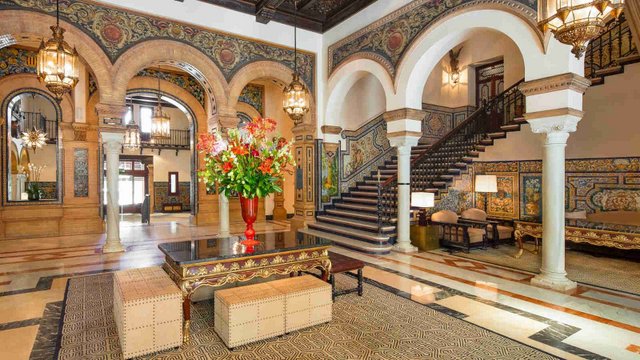Staying in a villa on the Andalucian coast offers the perfect opportunity to see the best of major Andalucian cities like Seville and Granada, which can easily be reached in a day trip.
Thanks to the excellent Andalucian motorways it’s perfectly possible to spend a day in Seville while staying on the coast. To get the most out of your trip, you will want to know the best things to do, so here are five must-sees for visiting Seville in a day.
Our Top Tips For a Day in Seville
Seville is the quintessential Andalusian city where magnificent monuments, haunting flamenco and fragrant orange blossom come together to create one of Spain’s most romantic cities. The capital of Andalucia and home to its regional government, Seville is a bustling metropolis with an impressive array of cultural and leisure attractions.
Divided by the winding Guadalquivir River, Seville has a skyline that is dominated by the Moorish-Christian Giralda tower (the city’s symbol) and the ultra-modern Pelli Tower (Andalusia’s tallest building, housing offices and a five-star hotel).
Seville should be explored without rushing – soak up the atmosphere in the Santa Cruz and riverside Triana districts, stroll along the river itself, and explore the Arenal, home to the world’s most famous bullring, La Maestranza.
It’s worth dedicating a couple of days to this lively city if you can, and we would be happy to assist with arranging “A Spoily Sleepover” in the city with our private guides. But if you only have a day to spend in the city, here are five unmissable things to do in Seville (with some optional evening extras).
Alcazar
The Alcazar palace, an enchanting architectural hotchpotch of Moorish, Mudéjar (Moorish-Christian), Gothic and Renaissance, is Seville’s answer to the Alhambra in Granada – in fact Moorish craftsmen worked on both palaces. The majestic rooms and patios with exquisite stucco work and intricate geometric azulejos (ceramic tiles) were commissioned by Pedro I, the Christian king who reigned in this part of Andalusian during the 14th century.
The craftsmanship is on a par with the Alhambra: admire the horseshoe and scalloped arches, and long rectangular pools designed for aesthetic purposes – beautiful reflections – as well as serving to lower the temperatures. The oldest part dates back to the 10th century, with a simple chamber and garden.
Highlights in the historic complex – still used by the Spanish royal family as a residence, making it the oldest palace still in use in Europe – include the baths of Maria Padilla, the Cenador de Carlos V, the Grutesco Wall, intricate Patio de las Doncellas, sumptuous Sala de los Embajadores where ambassadors were received – the gold mirrored domed ceiling represents the heavens – and the antique and tapestry-packed Royal Chambers.
The gardens are a treat for the senses with floral displays all year round, from jacaranda and jasmine to orange and pomegranate trees, and tiled benches at every turn to soak it all in. For a full synesthetic experience, try the Kleos Seville app which matches music to native territories of plant species.
If you’re a Game of Thrones fan, the gardens and pavilion may look familiar – the Alcazar was the Water Gardens of Dorne, home to Prince Doran of the House Martell. The palace and gardens are incredibly photogenic at every turn.
If you’re convinced by now that it’s worth staying the night, on summer evenings, outdoor concerts take place in the Alcazar Gardens – mostly classical music, with some medieval, jazz and flamenco. In addition, spectacular light shows take place in the gardens in autumn and winter, transforming the spaces into magical wonderlands.
Address: Patio de Banderas, s/n. 41004 Sevilla
Website: Real Alcázar de Sevilla
Cathedral
By any measure, Seville’s Cathedral is enormous – it’s the third-largest in the world and the largest Gothic cathedral. Started in the early 15th century, construction of Santa Maria de la Sede took more than a century.
This giant structure was built on top of the Moorish mosque, of which we can still see the minaret and the Patio de Naranjas (Orange Tree Courtyard), used for ablutions by the Islamic faithful until the Christian Reconquest in the mid-13th century.
Inside this vast place of worship, admire the main chapel whose golden altarpiece is the largest in the world (30m x 20m); the tomb of Christopher Columbus (the remains inside were recently confirmed definitively to be those of the explorer, after years of controversy); and the Royal Chapel with the tombs of several monarchs.
Another outstanding feature is the magnificent paintings including the Inmaculada by Golden Age master Murillo in the circular Chapter House, and St Peter Freed by the Angel by Valdes Leal, in the Sala del Pabellon, as well as masterpieces by Zurbarán and Flemish painters.
Next, climb the minaret, the original 12th-century Moorish tower with its later additions of 24 bells and the weathervane in the form of a bronze statue of Victorious Faith. Known as the Giraldillo (small turning object), the vane gave its name to the Giralda Tower, the city’s most famous landmark.
The ascent to the top is, unusually, via ramps, built to allow imams to climb the tower on horseback (several times a day, to call the faithful to prayer). The panoramic views of Seville are well worth the climb and give you a good idea of the city’s layout, especially Santa Cruz neighbourhood and the Alcazar palace complex.
As you leave through the Orange Tree courtyard, admire the mighty wooden doors of the Puerta del Perdon (Gate of Forgiveness), originally the entrance to the mosque, with their intricately carved bronze door knockers.
Address: Avenida de la Constitución s/n, 41004 Sevilla
Website: Cathedral of Seville
Santa Cruz
Barrio Santa Cruz, formerly the medieval Jewish quarter, is a maze of pretty alleyways, squares and whitewashed houses near the Cathedral and Alcazar. Lose yourself as you wander round the narrow streets and alleys (some no wider than two outstretched arms), pausing to admire the typically Andalusian wrought-iron grills, and glimpsing tiled courtyards lined with leafy plants, and flower-filled balconies. Dip into the curio-packed antique shops or enjoy a fino sherry and tapa at one of the terrace bars.
If you have time, visit the Casa de Pilatos (so-called because the 16th-century mansion is supposedly modelled on Pontius Pilate’s house in Jerusalem) with its exceptional ceramic tiles, Renaissance architecture, Roman statues, and delightful gardens.
Santa Cruz is also home to a must-visit for flamenco fans – the Flamenco Museum, where displays explain the background and art behind Spain’s best-known musical form, which encompasses guitar, singing and dance. Classes and evening shows are also held here (be sure to book in advance).
Address: Enter from Calle Mateos Gago, opposite the Giralda
Website: Barrio de Santa Cruz
Parque Maria Luisa
The lovely green space of Maria Luisa Park brings welcome respite from Seville’s hustle and bustle, and from the heat in warmer months. If you don’t fancy exploring the park on foot, hire a horse and carriage or a group bike (along with friends or family) to take you round. Small cafés provide perfect stops for refreshment.
The park, a mixture of formal gardens and parkland, was redesigned for the 1929 World Fair (Seville also hosted the event in 1992) and houses several pavilions including the magnificent semi-circular Plaza de España (confusingly, the name refers to both the building and the space in which it sits), the World’s Fair centrepiece. Each of Spain’s provinces is represented in a tiled alcove, with a province map and a key scene from its history.
For another perspective, you can hire a rowing boat to propel yourself along the small canal which follows the building’s curve, and is crossed by four bridges. All the balustrades and bridges are also covered in pretty blue, white and yellow ceramics – made in Triana, to show off Seville’s craftmanship to the Fair’s many thousands of visitors. The overall effects is mesmerising – so allow yourself at least an hour to wander around and take it all in.
Another good reason to extend your day trip into an overnight is IcónicaFest in June and July. This music event sets its stage in front of the building’s central portico, creating an astonishing backdrop.
Icónica brings big names such as Tom Jones and Take That (2024), and Justin Timberlake (2025). The building is lit up before the concert starts, with bars and food stalls plying their trade in the park’s main avenue, and DJs keep the party going afterwards until the small hours.
Address: Paseo de las Delicias s/n, 41013, Sevilla
Website: Maria Luisa Park
Hotel Alfonso XIII
Luxury landmark hotels reach a new dimension at the emblematic Alfonso XIII, built in neo-mudejar style by the eponymous king for the 1929 World’s Fair. Walk through the doors and you leave the busy city behind and enter a piece of Seville’s architectural heritage.
The central glass and brick courtyard is perfect for enjoying a leisurely tea or coffee (or a glass of something stronger) after a day’s sightseeing. A more sophisticated ambience in this five-star hotel is offered by the American Bar, with its Art Deco décor, black and white Hollywood portraits, and zingy blue walls.
Don’t miss the Divlos leather bags boutique, up the stairs next to the entrance to Ena (the hotel’s lovely terrace bar, named after the king’s wife, who was Queen Victoria’s granddaughter), selling delectable leather bags in pretty shades made in Ubrique, Andalucia.
Address: San Fernando 2, 41004, Seville
Website: Hotel Alfonso XIII
To read more about Seville, we love our friend Fiona’s guide for The Times.
If you’re staying with us in one of our Andalucian villas, do get in touch with our Guest Experience Team who would be happy to create a bespoke itinerary to enjoy the best of Seville in a day or with an overnight stay.
You might also like







